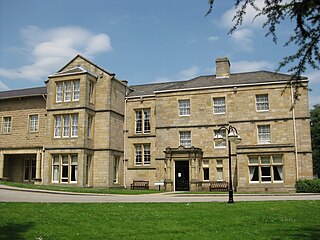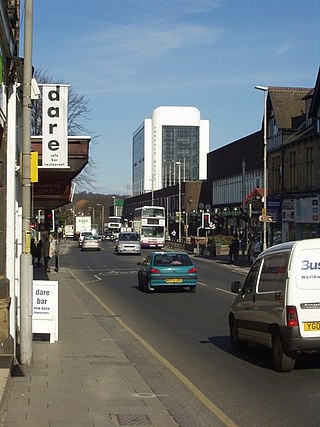
Chapeltown is a suburb of north-east Leeds, in West Yorkshire, England. It is part of the Leeds City Council Ward of Chapel Allerton. It is approximately one mile north of Leeds city centre.

Weetwood is an area between Headingley and Meanwood in north-west Leeds, West Yorkshire, England. It is bounded on the north by the A6120, on the west by the A660, on the east by Meanwood Beck and to the south by Hollin Lane. Weetwood Lane runs north and south through it.

Meanwood is a suburb and former village in north-west Leeds, West Yorkshire, England.

Woodhouse is a largely residential area just north of the city centre of Leeds and close to the University of Leeds. The area considered as Woodhouse is partly in the Little London and Woodhouse ward and partly in the Headingley & Hyde Park ward of City of Leeds metropolitan district.
Holt Park is a medium-sized low-rise 1970s housing estate in the northwest suburbs of Leeds, West Yorkshire, England. It is approximately 6 miles (10 km) from Leeds city centre situated between Tinshill, Cookridge and Adel, and is at the edge of the Leeds urban fringe, bordering the green belt which makes up two thirds of the metropolitan borough of the City of Leeds. The nearby Tinshill BT Tower dominates the skyline.

City Square is a paved area north of Leeds railway station at the junction of Park Row to the east and Wellington Street to the south. It is a triangular area where six roads meet: Infirmary Street and Park Row to the north, Boar Lane and Bishopsgate Street to the south-east, and Quebec Street and Wellington Street to the south-west. The only building with a direct frontage is the former General Post Office, on the north-west side.

The Otley Run is a pub crawl in Leeds, West Yorkshire. The popular route covers Far Headingley, Headingley and Hyde Park areas and commonly continues towards Leeds City Centre.

Briggate is a pedestrianised principal shopping street in Leeds city centre, England. Historically it was the main street, leading north from Leeds Bridge, and housed markets, merchant's houses and other business premises. It contains many historic buildings, including the oldest in the city, and others from the 19th and early-20th century, including two theatres. It is noted for the yards between some older buildings with alleyways giving access and Victorian shopping arcades, which were restored in late 20th century. The street was pedestrianised in the late-20th century.

The A660 is a major road in the Leeds and Bradford districts of West Yorkshire, England that runs from Leeds city centre to Burley-in-Wharfedale where it meets the A65. The A660 is approximately 10 miles (16 km) long, and crosses the watershed from Airedale to lower Wharfedale. For most of its length the road is in the metropolitan district of the City of Leeds; the last 0.4 miles (0.6 km) is in City of Bradford district.

The Grand Arcade is a shopping arcade located on New Briggate in Leeds, West Yorkshire, England, and a Grade II listed building. It was built by New Briggate Arcade Company Ltd in 1897, with Smith & Tweedal as architects, in Renaissance style with Modern Style details.

This is a list of halls of residence both on and off campus at the University of Leeds in Leeds, England.

Leeds Grammar School was an independent school founded 1552 in Leeds, West Yorkshire, England. Originally a male-only school, in August 2005 it merged with Leeds Girls' High School to form The Grammar School at Leeds. The two schools physically united in September 2008.

Park Square is a Georgian public square in central Leeds, West Yorkshire. The square is grassed over and is a traditional Georgian park. The square is in Leeds' financial quarter and is surrounded by Georgian buildings, which are occupied as offices, many by barristers and solicitors.

Leeds Civic Trust is a voluntary organisation and registered charity established in Leeds, West Yorkshire, England in 1965. Affiliated to the national charity Civic Voice, its stated purpose is "to stimulate public interest in and care for the beauty, history, and character of the city and locality, to encourage high standards of design, architecture and town planning; [and] to encourage the development and improvement of features of general public amenity".

All Souls' Church, Blackman Lane, in Leeds, West Yorkshire, England is a large Victorian Church of England parish church. Worship at All Souls is in the Anglo-Catholic tradition of the Church of England. The church is a Grade II* listed building.

39 Welsh Row is a Victorian former savings bank, in Jacobean Revival style, in Nantwich, Cheshire, England. It stands on the south side of Welsh Row at the junction with St Anne's Lane. Dating from 1846, it is listed at grade II. Nikolaus Pevsner describes number 39 as "the first noteworthy building" on Welsh Row, which he considers "the best street of Nantwich". The street has many listed buildings and is known for its mixture of architectural styles, including timber-framed black-and-white cottages such as the Wilbraham's and Widows' Almshouses, Georgian town houses such as Townwell House and number 83, and Victorian buildings such as the former Grammar School, Primitive Methodist Chapel and Tollemache Almshouses.

Kelly & Birchall, a partnership between Edward Birchall and John Kelly (1840–1904), was an architectural practice based in Leeds, England, from 1886 to 1904 and specialising in churches in the Italianate and Gothic Revival styles.

Mill Hill Chapel is a Unitarian church in Leeds, West Yorkshire, England. It is a member of the General Assembly of Unitarian and Free Christian Churches, the umbrella organisation for British Unitarians. The building, which stands in the centre of the city on City Square, was granted Grade II* listed status in 1963.

Salem Chapel is a former Congregational church, located on Hunslet Lane, Leeds, West Yorkshire, England. It is situated opposite the former Tetley's Brewery.

The Golden Beam is a pub and Grade II listed building located in the Headingley area of Leeds, West Yorkshire, England. It was built in c. 1912 for the Church of Christ, Scientist, and was known as the Elinor Lupton Centre from 1986 to 2010 when it was a school arts centre. It was designed by Piet de Jong and William Peel Schofield from the architectural firm Schofield and Berry. Constructed in white Portland stone in a mixed style of Egyptian Revival and Art Deco, it was originally built as a Sunday school in c. 1912–1914, extended in the 1930s with a church building and then used by the Leeds Girls' High School as a theatre and music centre from 1986 until 2010. The structure has architectural significance in the locality due to its distinct style and use of materials; many original features and fittings survive, including the entrance foyer, two staircases and a glazed lantern in the auditorium roof.



















